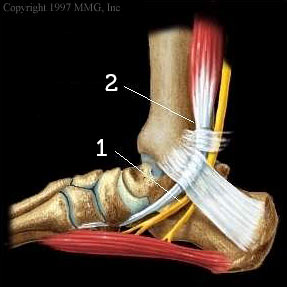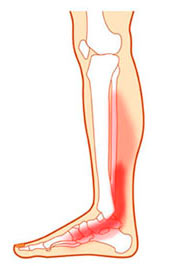
The posterior tibial tendon runs behind the inside of the ankle an attaches near the middle of the foot. Posterior tibial tendonitis is an inflammation to or along this tendon due to undue strain placed upon it, usually due to excessive rolling-in (pronation) of the affected foot. The normal function of this tendon is to aid in the holding-up or support of the arch of the foot. If this tendon is not functioning properly, the foot will roll-in excessively (pronate), resulting in “flat feet”, and an excessive strain on this tendon. This tendon dysfunction can also lead to other conditions, such as heel pain, arch pain, or arthritis.
Causes

Posterior tibial tendonitis is caused by years of overuse of the posterior tibial muscle, in the back of the leg, and a chronic strain of the associated tendon between the muscle and the foot bones it attaches to. Years of over-pronation can lead to posterior tibial tendon dysfunction or tendonitis. Initially the pain and swelling may be intermittent, but eventually it can progress and become consistent and in some cases disabling.
Treatment and prevention
There are generally two approaches to treating posterior tibial tendonitis: reduce the swelling and pain, and then control the foot long term to prevent recurrence. Treatment is usually non-surgical. This usually includes wearing a custom orthotic with the proper posting to support the rear foot and arch of the foot, in order to reduce strain on the posterior tibial tendon, and prevent excessive stretching through the bottom of the foot. The orthotic should also have some shock-absorbing qualities to it. Wearing shoes that also provide cushioning and shock absorption is helpful. Sometimes long-standing cases of posterior tibial tendonitis can result in painful arthritic conditions within the foot, and if so, surgery might be indicated as a treatment alternative.